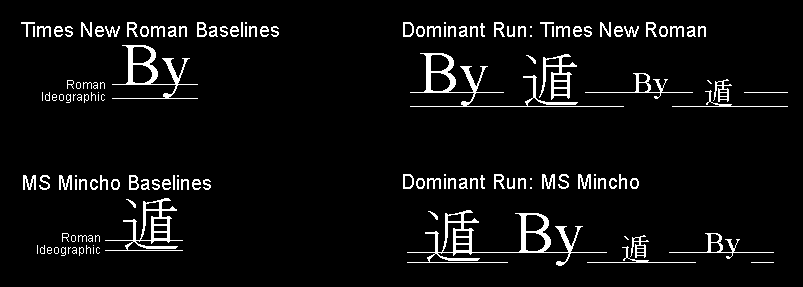Overview
Lines of text composed with glyphs of different scripts and point sizes need adjustment to correct interline spacing and alignment. For example, glyphs designed to be the same point size often differ in height and depth from one font to another (see Figure 5a). This variation can produce interline spacing that looks too large or too small, and diacritical marks, math symbols, subscripts, and superscripts may be clipped.

Figure 5a. Incorrect alignment of glyphs from Latin and Kanji (Latin dominant)
In addition, different baselines can cause text lines to waver visually as glyphs from different scripts are placed next to one another. For example, ideographic scripts position all glyphs on a low baseline. With Latin scripts, however, the baseline is higher, and some glyphs descend below it. Finally, several Indic scripts use a high "hanging baseline" to align the tops of the glyphs.
To solve these composition problems, the BASE table recommends baseline positions and min/max extents for each script (see Figure 5b). Script min/max extents can be modified for particular language systems or features.

Figure 5b. Proper alignment of glyphs from Latin and Kanji (Latin dominant)
Baseline Values
The BASE table uses a model that assumes one script at one size is the "dominant run" during text processing—that is, all other baselines are defined in relation to this the dominant run.
For example, Latin glyphs and the ideographic Kanji glyphs have different baselines. If a Latin script of a particular size is specified as the dominant run, then all Latin glyphs of all sizes will be aligned on the roman baseline, and all Kanji glyphs will be aligned on the lower ideographic baseline defined for use with Latin text. As a result, all glyphs will look aligned within each line of text.
The BASE table supplies recommended baseline positions; a client can specify others. For instance, the client may want to assign baseline positions different from those in the font.

Figure 5c. Comparing Latin and Kanji baselines, with characters aligned according to the dominant run
Min/Max Extent Values
The BASE table gives clients the option of using script, language system, or feature-specific extent values to improve composition (see Figure 5c). For example, suppose a font contains glyphs in Latin and Arabic scripts, and the min/max extents defined for the Arabic script are larger than the Latin extents. The font also supports Urdu, a language system that includes specific variants of the Arabic glyphs, and some Urdu variants require larger min/max extents than the default Arabic extents. To accommodate the Urdu glyphs, the BASE table can define language-specific min/max extent values that will override the default Arabic extents—but only when rendering Urdu glyphs.
The BASE table also can define feature-specific min/max values that apply only when a particular feature is enabled. Suppose that the font described earlier also supports the Farsi language system, which has one feature that requires a minor alteration of the Arabic script extents to display properly. The BASE table can specify these extent values and apply them only when that feature is enabled in the Farsi language.



